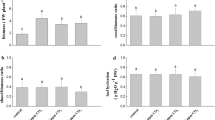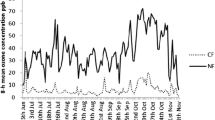Abstract
Total and individual glucosinolate contents of broccoli cv Marathon were assessed at ambient CO2 (430–480 ppm) and elevated atmospheric CO2 (685–820 ppm) to determine the ecological relationship between changing atmospheric CO2 concentrations and phytochemicals. Elevated atmospheric CO2 concentration had a differing effect on individual glucosinolates and glucosinolate groups. Total glucosinolate content increased at elevated atmospheric CO2 concentration as a result of a strong increase in both methylsulfinylalkyl glucosinolates glucoraphanin and glucoiberin. In contrast, indole glucosinolates simultaneously decreased, predominantly because of a reduction of glucobrassicin and 4-methoxy-glucobrassicin contents. We conclude that changes in N content and N/S ratios as well as alterations in photochemical processes at elevated atmospheric CO2 concentration can influence total and individual glucosinolates contents of Brassicaceae, as demonstrated in the greenhouse, for broccoli.



Similar content being viewed by others
References
Amthor, J. S. 2001. Effects of atmospheric CO2 concentration on wheat yield: review of results from experiments using various approaches to control CO2 concentration. Field Crops Res. 73:1–34.
Brown, A., Yousef, G., Jeffrey, E., Klein, B., Wallig, M., Kushad, M., and Juvik, J. 2002. Glucosinolate profiles in broccoli: variation in levels and implications in breeding for cancer chemoprotection. J. Am. Soc. Hortic. 27:807–813.
Chen, S. X. and Andreasson, E. 2001. Update on glucosinolate metabolism and transport. Plant Physiol. Biochem. 39:743–758.
Chen, S. X, Petersen, B. L., Olsen, C. E., Schulz, A., and Halkier, B. A. 2001. Long-distance phloem transport of glucosinolates in Arabidopsis. Plant Physiol. 127:194–201.
Cotrufo, M. F., Ineson, P., and Scott, A. 1998. Elevated CO2 reduces the nitrogen concentration of plant tissues. Glob. Chang. Biol. 4:43–54.
Craigon, J., Fangmeier, A., Jones, M., Donnelly, A., Bindi, M., De Temmerman, L., Persson, K., and Ojanpera, K. 2002. Growth and marketable-yield responses of potato to increased CO2 and ozone. Eur. J. Agron. 17:273–289.
Dekker, M. and Verkerk, R. 2003. Dealing with variability in food production chains: a tool to enhance the sensitivity of epidemiological studies on phytochemicals. Eur. J. Nutr. 42:76–72.
Genty, B., Briantais, J., and Baker, N. 1989. The relationship between the quantum yield of photosynthetic electron transport and quenching of chlorophyll fluorescence. Biochim. Biophyis. Acta 990:87–92.
Gerber, S., Joos, F., and Prentice, I. C. 2004. Sensitive of a dynamic global vegetation model to climate and atmospheric CO2. Glob. Chang. Biol. 10:1223–1239.
Grubb, C. and Abel, S. 2006. Glucosinolate metabolism and its control. Trends Plant Sci. 11:89–100.
Habash, D. Z., Paul, M. J., Parry, M. A., Keys, A. J., and Lawlor, D. W. 1995. Increased capacity for photosynthesis in wheat grown at elevated CO2—the relationship between electron-transport and carbon metabolism. Planta 197:482–489.
Halkier, B. A. and Du, L. 1997. The biosynthesis of glucosinolates. Trends Plant Sci. Rev. 2:425–431.
He, H., Fingerling, G., and Schnitzler, W. H. 2000. Jahreszeitliche Variation der Glucosinolatgehalte in Brassica campestris L. spp. chinensis. J. Appl. Bot. 74:198–202.
Hesse, H., Nikiforova, V., Gakiere, B., and Hoefgen, R. 2004. Molecular analysis and control of cysteine biosynthesis: integration of nitrogen and sulphur metabolism. J. Exp. Bot. 55:1283–1292.
Holst, B. and Williamson, G. 2004. A critical review of the bioavailability of glucosinolates and related compounds. Nat. Prod. Rep. 21:425–447.
Karowe, D. N., Seimens, D. H., and Mitchell-Olds, T. 1997. Species-specific response of glucosinolate content to elevated atmospheric CO2. J. Chem. Ecol. 23:2569–2582.
Kopriva, S. and Rennenberg, H. 2004. Control of sulphate assimilation and glutathione synthesis: interaction with N and C metabolism. J. Exp. Bot. 55:1831–1842.
Krumbein, A. and Schonhof, I. 2001. Influence of temperature and irradiation on glucosinolates in broccoli heads, pp. 477–479, in W. Pfannhauser, G. Fenwick, and S. Khokhar (eds.). Biologically-active Phytochemicals in Food. Royal Society of Chemistry Cambridge, UK.
Krumbein, A., Schonhof, I., and Schreiner, M. 2005. Composition and contents of phytochemicals (glucosinolates, carotenoids and chlorophylls) and ascorbic acid in selected Brassica species (B. juncea, B. rapa subsp. nipposinica var. chinoleifera, B. rapa subsp. chinensis, B. rapa subsp. rapa). Appl. Bot. Food Qual. 79:168–174.
Krupa, S. 2003. Atmosphere and agriculture in the new millennium. Environ. Pollut. 126:293–300.
Larcher, W. 1994. Ökologie der Pflanzen auf physiologischer Grundlage. Ulmer, Stuttgart.
Maevskaya, S. N., Andreeva, T. F., Voevuskaya, Yu, S., and Cherkanova, N. N. 1990. Effect of elevated CO2 concentration on photosynthesis and nitrogen metabolism of mustard plants. Sov. Plant Physiol. 37:687–692.
Mewis, I., Appel, H. M., Hom, A., Raina, R., and Schultz, J. C. 2005. Major signaling pathways modulate Arabidopsis thaliana (L.) glucosinolate accumulation and response to both phloem feeding and chewing insects. Plant Physiol. 138:1149–1162.
Mikkelsen, M. D., Petersen, B., Olsen, C., and Halkier, B. A. 2002. Biosynthesis and metabolic engineering of glucosinolates. Amino Acids 22:279–295.
Mikkelsen, M. D., Petersen, B., Glawischnig, E., Jensen, A. B., Andreasson, E., and Halkier, B. A. 2003. Modulation of CYP79 genes and glucosinolate profile in Arabidopsis by defence signalling pathways. Plant Physiol. 131:298–308.
Mishra, R. S., Abdin, M. Z., and Uprety, D. C. 1999. Interactive effects of elevated CO2 and moisture stress on the photosynthesis, water relation and growth of Brassica species. J. Agron. Crop Sci. 182:223–229.
Norby, R. J. and Luo, Y. 2004. Evaluating ecosystem responses to rising atmospheric CO2 and global warming in a multi-factor world. New Phytol. 162:281–293.
Pataki, D. E., Bowling, D. R., Ehleringer, J. R., and Zobitz, J. M. 2006. High resolution monitoring of urban carbon dioxide sources. Geophys. Res. Lett. 33, LO3813:1–5.
Reddy, G. V. P., Tossavainen, P., Nerg, A.-M., and Holopainen, J. K. 2004. Elevated atmospheric CO2 affects the chemical quality of Brassica plants and the growth rate of the specialist Plutella xylostella, but not the generalist, Spodoptera littoralis. J. Agric. Food Chem. 52:4185–4191.
Scheuner, E., Schmidt, S., Krumbein, A., Schonhof, I., and Schreiner, M. 2005. Effect of methionine foliar fertilization on glucosinolates in broccoli and radish. J. Plant Nutr. Soil Sci. 168:275–277.
Schonhof, I., Krumbein, A., Schreiner, M., and Gutezeit, B. 1999. Bioactive substances in cruciferous products, pp. 222–226, in Agri-Food II—Quality Management of Fruits and Vegetables. The Royal Society of Chemistry Cambridge UK, special publication 229.
Schonhof, I., Krumbein, A., and Brückner, B. 2004. Genotypic effects on glucosinolates and sensory properties of broccoli and cauliflower. Food 48:25–33.
Schonhof, I., Klärig, H.-P., Krumbein, A., Claußen, W., and Schreiner, M., In press. Effect of temperature increase under low radiation conditions on phytochemicals and ascorbic acid in greenhouse grown broccoli. Agric. Ecosys. Environ. http://dx.doi.org/10.1016/j.agee.2006.06.018.
Schreiner, M. 2005. Vegetable crop management strategies to increase the quantity of phytochemicals. Eur. J. Nutr. 44:85–94.
Shattuck, V. I. and Wang, W. 1994. Growth stress induces glucosinolate changes in pakchoy (Brassica campestris ssp. chinensis). Can. J. Plant Sci. 74:595–601.
Van Kooten, O. and Snel, J. 1990. The use of chlorophyll fluorescence nomenclature in plant stress physiology. Photosynth. Res. 25:147–150.
VDLUFA. 1991. Method book I. VDLUFA_verlag (Verband deutscher landwirtschaftlicher Untersuchungs- und Forschungsanstalten), Darmstadt.
Wetter, L. R. and Chisholm, M. D. 1968. Sources of sulphur in thioglucosides of various higher plants. Can. J. Biochem. 46:931–935.
Wurr, D. C. E., Hand, D. W., Edmondson, R. N., Fellows, J. R., Hannah, M. A., and Cribb, D. M. 1998. Climate change: a response surface study of the effects of CO2 and temperature on the growth of beetroot, carrots and onions. J. Agric. Sci. 131:125–133.
Wurr, D. C. E., Edmondson, R. N., and Fellows, J. R. 2000. Climate change: a response surface study of the effects of CO2 and temperature on the growth of French beans. J. Agric. Sci. 135:379–387.
Zhang, Y. 2004. Cancer chemoprevention with sulforaphane, a dietary isothiocyanate, pp. 121–141, in Y. Bao and R. Fenwick (eds.). Phytochemical in Health and Disease. Marcel Dekker, New York, Basel.
Author information
Authors and Affiliations
Corresponding author
Rights and permissions
About this article
Cite this article
Schonhof, I., Kläring, HP., Krumbein, A. et al. Interaction Between Atmospheric CO2 and Glucosinolates in Broccoli. J Chem Ecol 33, 105–114 (2007). https://doi.org/10.1007/s10886-006-9202-0
Published:
Issue Date:
DOI: https://doi.org/10.1007/s10886-006-9202-0




